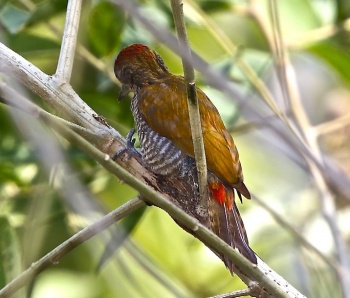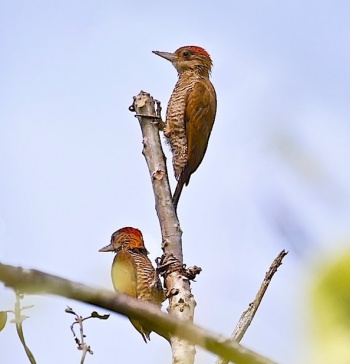- Veniliornis kirkii
Identification
15–16 cm (6-6¼ in)
- Golden-olive upperparts
- Buff wing spots
- Red rump
- Buffy-white underparts with fine dark brown bars
- Blackish brown tail
- Black bill
Adult males: red crown and yellow nape
Adult females: dark brown crown, orange-brown nape
Distribution
Central and South America:
Central America: Costa Rica, Panama, Trinidad, Tobago
South America: Colombia, Venezuela, Guyana, Ecuador, Peru and Brazil
Taxonomy
Subspecies

Subspecies neglectus
Photo by Stanley Jones
Bosque del Rio Tigre Lodge, Osa Peninsula, Puntarenas Province, Costa Rica, February 2015
Photo by Stanley Jones
Bosque del Rio Tigre Lodge, Osa Peninsula, Puntarenas Province, Costa Rica, February 2015
There are 5 subspecies[1]:
- V. k. neglectus:
- South West Costa Rica and western Panama; Coiba Island
- V. k. cecilii:
- V. k. kirkii:
- V. k. continentalis:
- North and western Venezuela
- V. k. monticola:
- Tepuis of south-eastern Venezuela (Mount Roraima and Cerro Uei-tepui)
Habitat
A variety of woodland habitats, in lowlands and foothills, including adjacent second growth.
Behaviour
Breeding
They make a nest hole in a dead tree; the clutch contains 2-3 white eggs.
Diet
They eat adult and larval wood boring beetles and insects.
Vocalisation
Call: a repetitive quee-quee-quee.
References
- Clements, J. F., T. S. Schulenberg, M. J. Iliff, D. Roberson, T. A. Fredericks, B. L. Sullivan, and C. L. Wood. 2017. The eBird/Clements checklist of birds of the world: v2017, with updates to August 2017. Downloaded from http://www.birds.cornell.edu/clementschecklist/download/
- Avibase
- Handbook of the Birds of the World Alive (retrieved Apr 2018)
- Wikipedia
Recommended Citation
- BirdForum Opus contributors. (2024) Red-rumped Woodpecker. In: BirdForum, the forum for wild birds and birding. Retrieved 20 April 2024 from https://www.birdforum.net/opus/Red-rumped_Woodpecker





